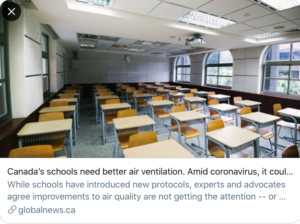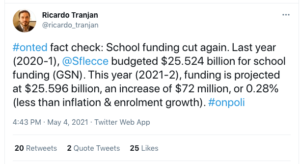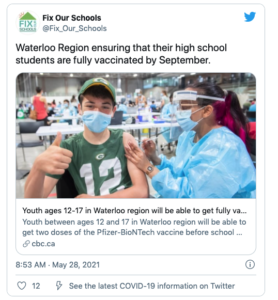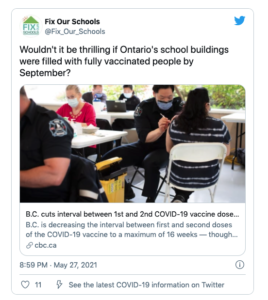Public Schools are Critical Infrastructure – as are Paid Sick Days
The Oxford English dictionary defines infrastructure as, “the basic physical and organizational structures and facilities needed for the operation of a society or enterprise.” Since the inception of the Fix Our Schools campaign back in 2014, we’ve proposed that publicly funded schools are critical infrastructure and must be prioritized and funded as such by both our provincial and federal governments.

Amidst the global COVID-19 pandemic, the importance of prioritizing schools as critical infrastructure has been highlighted. Issues such as the $16.3-billion repair backlog in Ontario’s schools prior to the pandemic’s start, a lack of any standard of good repair for Ontario’s schools, and the need for proper ventilation in classrooms and schools to prevent COVID’s aerosol spread have all come to the forefront.
More recently, Fix Our Schools joined the call for paid sick days, recognizing that addressing the root causes of COVID-19 spread in communities was absolutely necessary for public schools to be considered safe for in-person learning. In essence, a paid sick days program has become a necessary part of our public infrastructure that enables Ontario’s workers to stay home when feeling unwell, get tested for COVID, self-isolate if needed, and get vaccinated.
The Ford government was incredibly slow to recognize paid sick days as critical public infrastructure. After 15 months of workplace outbreaks being a key driver in COVID-19 spread, our provincial government finally came to the table with a paid sick days plan. This plan, coming amidst a horrific third wave, has been declared “pitifully inadequate” by opposition parties and medical establishment. Workers only receive 3 days (instead of 10-14 as recommended), and the plan is only temporary, expiring in September 2021.
Ventilation and Air Quality in Classrooms and Schools
The COVID-19 pandemic has certainly highlighted that public schools are critical infrastructure in our society. The need for ventilation in classrooms has become a priority as good ventilation was proven to significantly reduce COVID transmission. Fix Our Schools has always advocated for good ventilation and air quality as integral to creating healthy, safe, optimum learning environments, and we began exerting pressure on our provincial government as early as June 2020 to prioritize investing in schools as critical infrastructure to ensure a safe re-opening of Ontario’s public schools.
By mid-June, the Ford government had issued a loose “approach” to school re-opening in Ontario that recognized improved ventilation in classrooms and schools as a key factor in safe reopening but, surprisingly, the Ford government did not allocate any new funding to school boards to make ventilation improvements. This was akin to a parent sending a child to a grocery store to buy the family’s groceries and giving them zero dollars to do so – a clear set-up for failure.
By the end of June, Fix Our Schools had crowd-sourced details on ventilation in classrooms across Ontario, and the news was not good.
 In fact, many schools across the province have classrooms with no windows, windows that do not open, and/or windows that only open a tiny bit – hardly conducive to good air-flow and ventilation:
In fact, many schools across the province have classrooms with no windows, windows that do not open, and/or windows that only open a tiny bit – hardly conducive to good air-flow and ventilation:
“The HVAC system at York Humber High School in Toronto has been broken for more than a decade.”
“My daughter attends Tom Thomson School in Burlington. Her classroom this year only had windows along the top of the outside classroom wall. These windows were not reachable, provided very little natural light, and did not open.“
“Harry Bowes Public School in Whitchurch-Stouffville is a lovely school and built within the past 20 years. However, the air circulation is terrible, and windows barely even open. Most teachers and students are continually sick and allergies are a problem while in the building as well.”
“Memorial City Elementary School in Hamilton is 100 years old and the dust coming out of the ventilation system seems that old too. While the windows are newer, the tracks are so badly gummed up that only a couple can be opened and they cannot open much.”
“At Mount Hope School in Hamilton, the upper-level windows do not open at all and the lower level windows only open a bit.”
“As a parent, I’ve been concerned about poor ventilation, no fresh air at Equinox Alternative School in Toronto for years! I am a volunteer in the school and can confirm it is almost never a comfortable temperature. With the added serious concerns regarding COVID-19, and the clear medical guidance (commissioned by the Province!) that fresh air can help reduce transmission, it’s the time to invest in windows.”
“At Earl of March Secondary School in Ottawa, there are many interior classrooms that do not have windows. The school is 50 years old and the HVAC has never worked properly.”
“At Holy Trinity Catholic Elementary School in Sudbury, the kindergarten classroom has no windows. It used to be a resource room, but was converted into a regular classroom due to increased enrollment.”
And still, no funding provided by our provincial government so that school boards could actually start addressing ventilation issues. In fact, even by the end of July, the Ford government had not provided any additional funding for school boards to use for ventilation improvements. As of late July, Minister Lecce was still insisting that the routine $1.4-B/year funding for school repair and renewal (NOTE: this inadequate level of “investment” had led to a $16.3-B repair backlog in Ontario schools), ought to be sufficient for school boards to make schools safe to re-open amidst the COVID-19 pandemic. This was recognized as untenable, as evidenced by the Toronto Star Editorial Board’s piece on July 27, 2020 entitled, “Ontario’s back-to-school plan must come with cash“, “whatever the exact amount, it will be money well spent. As a society, we have to figure out a way to make the return to school both successful and safe. When the province unveils its back-to-school plan this week, it should also provide its own estimate of the cost — and assure Ontarians that it will find the money. Students, parents, and educators deserve no less.“
It was not until July 30, that the Ford government started to realize that school boards would, in fact, require additional funding to make schools safe for re-opening. Too late to make a difference for a September re-opening, Education Minister Lecce finally announced a mere $50-M in funding for school boards to improve ventilation in classrooms, waiting a full two months after SickKids had clearly identified ventilation as a key element to safe in-person learning. The $50-M in funding for ventilation equated to approximately $10,000 per school in Ontario. This was too little funding provided far too late – mere weeks before schools were re-opening.
Fix Our Schools identified that ventilation continued to be a big concern in Ontario’s schools as of late August – mere weeks before schools were meant to re-open. Experts agreed with this assessment:
As Ontario’s children are relegated to exclusive at-home learning for the third time amidst this pandemic, ventilation continues to be a hot topic. It is one of the keys to safe in-person learning amidst a pandemic, and our hope is that good ventilation and air quality will continue to be prioritized well beyond this pandemic as a key element of safe, healthy, effective school infrastructure.
Moving Forward in Education Planning
 Education Minister Lecce just made the annual GSN (Grants for Student Needs) announcements, which provide further details to Ontario’s school boards on how previously announced funding in the provincial budget must be allocated. Economist Ricardo Tranjan reminded us that the last provincial budget in November did not contain good news for education funding.
Education Minister Lecce just made the annual GSN (Grants for Student Needs) announcements, which provide further details to Ontario’s school boards on how previously announced funding in the provincial budget must be allocated. Economist Ricardo Tranjan reminded us that the last provincial budget in November did not contain good news for education funding.
Minister Lecce also proudly revealed “additional funding” of $1.6-B for COVID-related costs that had not been included in the most recent provincial budget. This announcement was received with skepticism by many. Liz Stuart, president of the Ontario English Catholic Teachers’ Association, commented that this provincial funding “does not keep pace” with boards’ actual costs and “while Minister Lecce trumpets ‘additional funding’ to respond to COVID-19, it should not be lost on anyone that he is providing the same inadequate amount as last year.”
Embedded in Minister Lecce’s announcements last week was also a clear intent to move forward with cementing online learning as a choice within our public education system. This seems like yet another example of the Ford government using the cover of the COVID-pandemic to push its own political agenda; in this instance – an expansion of online learning.
Noticeably absent from the provincial announcements last week was any discussion of whether Ontario’s schools might re-open at all this school year for in-person learning. As Dr. Daphne Korczak, a child and adolescent psychiatrist and Chair of the Canadian Pediatric Society’s Mental Health Task Force and Dr. Mark Feldman, a pediatrician and vice president of the Canadian Pediatric Society, wrote in an opinion piece entitled, For the sake of the kids, don’t write off the school year just yet, “Is the plan to quietly let the clock run down, rather than to determine how to provide students with at least a few weeks of quasi-normalcy and closure — so important at the end of the year — especially for students in transition to new schools and new surroundings?
As physicians, we support evidence-based measures that will stem this third wave. We are part of the health care system, and we worry about it becoming overwhelmed. We are also concerned about the well-being of our colleagues in adult medicine, who have borne an unimaginable burden over these past 14 months.
But we cannot let children and youth become the pandemic’s collateral damage.
School doors should be the first to open and the last to close.“
While Minister Lecce and Premier Ford claim to have prioritized children and education amidst the pandemic, their announcements last week certainly do not support this claim.
 Aside from bringing clarity on metrics and a plan for the remainder of the 2020/21 school year, the Ford government must also be looking ahead to the 2021/22 school year. When Ontario’s students head back to school this coming September, wouldn’t it be thrilling if schools were filled with fully vaccinated people? Prioritizing Ontario’s students, their teachers and education workers to be fully vaccinated by August 24 (First Day of School Minus 14 days!) seems like one step towards a safe September. Already, at a local level, we are seeing certain Ontario regions move ahead with a focus on full vaccination of students.
Aside from bringing clarity on metrics and a plan for the remainder of the 2020/21 school year, the Ford government must also be looking ahead to the 2021/22 school year. When Ontario’s students head back to school this coming September, wouldn’t it be thrilling if schools were filled with fully vaccinated people? Prioritizing Ontario’s students, their teachers and education workers to be fully vaccinated by August 24 (First Day of School Minus 14 days!) seems like one step towards a safe September. Already, at a local level, we are seeing certain Ontario regions move ahead with a focus on full vaccination of students. While we’re on the topic of September, wouldn’t it be thrilling if every classroom was properly ventilated and metrics were in place for indoor air quality for our students to ensure not only their health but also an optimum learning environment? Wouldn’t it be thrilling if the Ford government actually started investing in schools to eliminate the $16.3-B disrepair that existed in these buildings even before COVID?
While we’re on the topic of September, wouldn’t it be thrilling if every classroom was properly ventilated and metrics were in place for indoor air quality for our students to ensure not only their health but also an optimum learning environment? Wouldn’t it be thrilling if the Ford government actually started investing in schools to eliminate the $16.3-B disrepair that existed in these buildings even before COVID?


